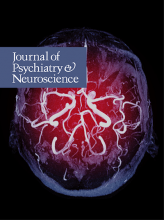A 27-year old woman with a history of bipolar II disorder was referred with a history of nonresponse to 2 adequate trials of antidepressants for the index episode of depression. During a routine inquiry to assess symptoms of obsessive–compulsive disorder (OCD), she reported a history of recurrent pulling of hair from her scalp and her eyebrows, also known as trichotillomania (TTM), since the birth of her only child 8 months earlier. Symptoms of TTM persisted despite the patient’s repeated attempts to stop the behaviour and treatment with antidepressants. She denied having had any obsessions or compulsions before the onset of TTM, but she reported having experienced panic attacks on occasion. Her family history was positive for postpartum depression and OCD in her mother. The patient was physically healthy, and recent blood work confirmed normal thyroid function.
The patient met the DSM-5 diagnostic criteria for bipolar II disorder with peripartum onset and TTM. Citalopram was tapered off owing to its lack of effectiveness for both bipolar disorder and TTM. Lithium was recommended owing to its efficacy in the acute treatment of bipolar II depression. The patient was started on 300 mg daily, and the dose was eventually optimized to 750 mg, attaining a serum level of 0.67 mmol/L. At the 3-month follow-up visit, symptoms of both depression and TTM had fully remitted. The patient has remained symptom-free for 1 year and continues to take 750 mg of lithium daily.
Trichotillomania is no longer considered an impulse disorder; it has been reclassified as an obsessive–compulsive and related disorder (OCRD) in DSM-5.1 Although DSM-5 does not allow the use of the “with peripartum onset” specifier to characterize OCRD, it acknowledges that “onset or exacerbation of obsessive–compulsive disorder, as well as symptoms that can interfere with the mother–infant relationship, have been reported in the postpartum period.” Trichotillomania can be debilitating; however, patients are reluctant to seek help owing to feelings of shame and embarrassment. Onset is typically during early adolescence, but there are occasional reports of onset after childbirth. The disorder commonly occurs comorbidly with major depression, anxiety disorders and substance use disorders and occasionally with bipolar II disorder.
Patients presenting with TTM should undergo thorough psychiatric assessment for diagnostic confirmation and psychiatric comorbidity.2 Medical evaluation is indicated for patients with a history of swallowing hair after pulling, also known as trichophagia. As TTM impacts psychosocial functioning and quality of life, patients should be assessed for self-esteem, social interaction, participation in recreational activities and work productivity.3
Currently there are no treatments for TTM approved by the US Food and Drug Administration, which poses a challenge for physicians when selecting appropriate pharmacotherapy. Drugs from different classes have been studied, including antidepressants, anticonvulsants, central nervous system stimulants, glutamate modulators, opioid antagonists and neuroleptics.4,5 Early studies focused on serotonin reuptake inhibitors; however, there is no clear evidence of their effectiveness in the treatment of TTM. N-acetylcysteine (NAC), a glutamatergic agent, has also been studied. A recent systematic review of 4 randomized, double-blind placebo-controlled trials on the use of NAC in the treatment of TTM found inconclusive evidence, but suggested that NAC may still be useful as a treatment for OCRD owing to its relatively benign side effect profile.5,6 There are occasional reports on the use of lithium that suggest the drug may be effective in patients with comorbid bipolar disorder.7,8 Regarding psychotherapy, behavioural therapy, specifically habit reversal therapy and group cognitive-behavioural therapy, may be beneficial.9
In the absence of clear guidance about the choice of appropriate drugs, selection of medication should take into consideration factors such as the severity of the disorder, psychiatric comorbidity and timing of the onset of TTM.10 There is emerging evidence that psychiatric disorders with postpartum onset are possibly early manifestations of bipolar disorder.11,12 Early recognition and appropriate treatment of bipolar disorder in these patients may help prevent the harmful consequences of both bipolar disorder and TTM.
Footnotes
The information in this column is not intended as a definitive treatment strategy but as a suggested approach for clinicians treating patients with similar histories. Individual cases may vary and should be evaluated carefully before treatment is provided. The patient described in this column is a composite with characteristics of several real patients.
Competing interests: V. Sharma reports grants from Assurex, Genome Canada, Sunovion Pharmaceuticals, Stanley Medical Research Institute and Neurocrine Biosciences outside the submitted work.









